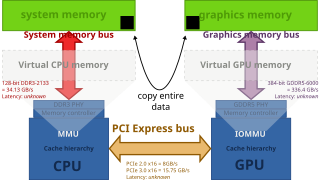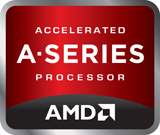- Steps performed when offloading calculations to the GPU on a non-HSA system
- Steps performed when offloading calculations to the GPU on a HSA system, using the HSA functionality
Overview
This section needs additional citations for verification .(May 2014) |
Originally introduced by embedded systems such as the Cell Broadband Engine, sharing system memory directly between multiple system actors makes heterogeneous computing more mainstream. Heterogeneous computing itself refers to systems that contain multiple processing units – central processing units (CPUs), graphics processing units (GPUs), digital signal processors (DSPs), or any type of application-specific integrated circuits (ASICs). The system architecture allows any accelerator, for instance a graphics processor, to operate at the same processing level as the system's CPU.
Among its main features, HSA defines a unified virtual address space for compute devices: where GPUs traditionally have their own memory, separate from the main (CPU) memory, HSA requires these devices to share page tables so that devices can exchange data by sharing pointers. This is to be supported by custom memory management units. [2] : 6–7 To render interoperability possible and also to ease various aspects of programming, HSA is intended to be ISA-agnostic for both CPUs and accelerators, and to support high-level programming languages.
So far, the HSA specifications cover:
HSA Intermediate Layer
HSAIL (Heterogeneous System Architecture Intermediate Language), a virtual instruction set for parallel programs
- similar[ according to whom? ] to LLVM Intermediate Representation and SPIR (used by OpenCL and Vulkan)
- finalized to a specific instruction set by a JIT compiler
- make late decisions on which core(s) should run a task
- explicitly parallel
- supports exceptions, virtual functions and other high-level features
- debugging support
HSA memory model
- compatible with C++11, OpenCL, Java and .NET memory models
- relaxed consistency
- designed to support both managed languages (e.g. Java) and unmanaged languages (e.g. C)
- will make it much easier to develop 3rd-party compilers for a wide range of heterogeneous products programmed in Fortran, C++, C++ AMP, Java, et al.
HSA dispatcher and run-time
- designed to enable heterogeneous task queueing: a work queue per core, distribution of work into queues, load balancing by work stealing
- any core can schedule work for any other, including itself
- significant reduction of overhead of scheduling work for a core
Mobile devices are one of the HSA's application areas, in which it yields improved power efficiency. [6]
Block diagrams
The illustrations below compare CPU-GPU coordination under HSA versus under traditional architectures.
- Standard architecture with a discrete GPU attached to the PCI Express bus. Zero-copy between the GPU and CPU is not possible due to distinct physical memories.
- HSA brings unified virtual memory and facilitates passing pointers over PCI Express instead of copying the entire data.
- In partitioned main memory, one part of the system memory is exclusively allocated to the GPU. As a result, zero-copy operation is not possible.
- Unified main memory, where GPU and CPU are HSA-enabled. This makes zero-copy operation possible. [8]
















